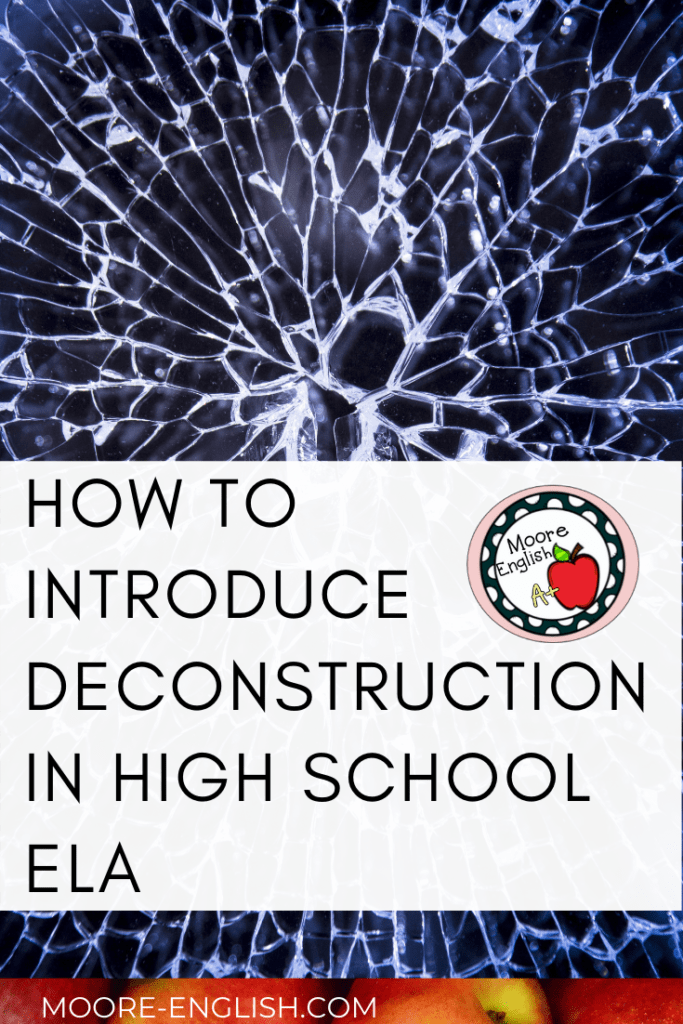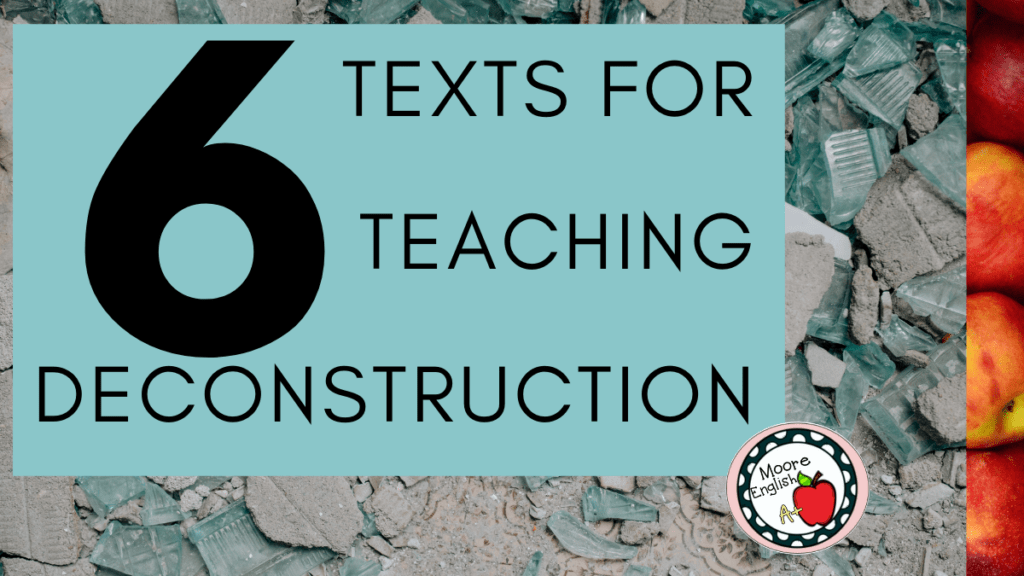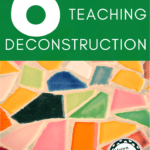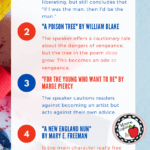Literary criticism is one of my favorite ways to approach a text. Once I’ve introduced literary criticism and students have grappled with the basics, they really start to engage in creative thinking.
I am constantly blown away with students’ abilities to see texts in new, innovative ways. When I am fortunate to have a group of students that really takes to literary criticism, I challenge them by introducing deconstruction. To be clear, this is not a critical lens that I always teach. Instead, this is the *bonus* lens I use for students that are really rocking with literary criticism.
This post this post may contain affiliate links. Please read the Terms of Use.
Where to Begin with Deconstruction
At the high school level, we do not need to delve into the entire history of deconstruction. With this in mind, I introduce deconstruction with formalism. At this point, students are familiar with the formalist approach. After all, for most of their educational careers, teachers and assessments have defaulted to this perspective.
Since we’re working toward a new critical lens, it’s important to choose a non-threatening and/or familiar text. As an enthusiastic Taylor Swift fan, I often turn to her work for an entry point into literary criticism. In this case, “The Man” is a perfect song for introducing deconstructionist literary criticism.
To begin, students would use the 4 steps for pre-reading poetry to annotate “The Man.” Then, they would think-pair-share to arrive at a formalist reading of the text, perhaps one related to double standards or society’s expectations of womxn. And that’s where deconstruction begins–with a unified perspective of a text.
Then, and this is my favorite part, students take that unified perspective and find ways that the text works against itself. In the case of “The Man,” a song about female empowerment ends by saying “If I was a man, then I’d be the man.” So the best thing a womxn can be is not a womxn? Oh, okay. Likely that wasn’t Swift’s intention, but in a deconstructionist world, that’s not relevant.
Next Steps with Deconstruction
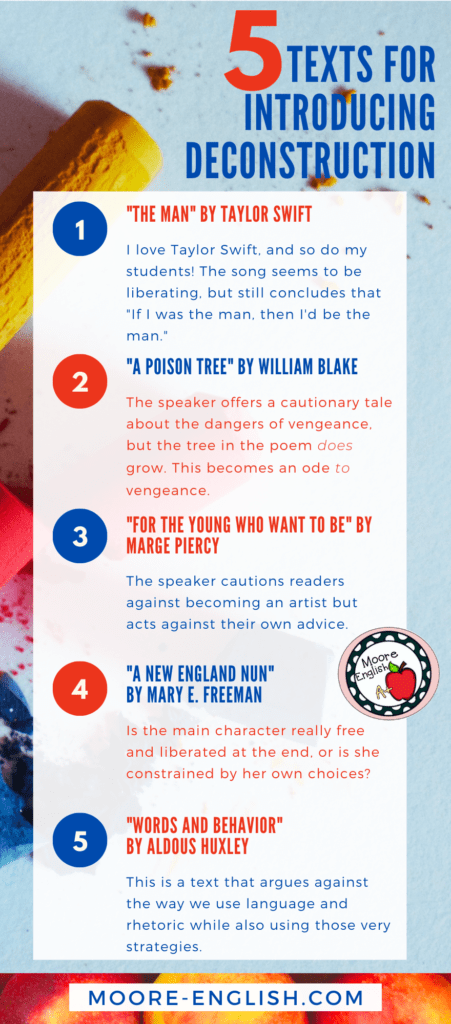
After our Taylor Swift lesson, students apply a deconstructionist lens to other familiar texts, perhaps whatever we have most recently read or what we are reading now. If that doesn’t suit our needs, we will try a short work like a poem. Here are two poetry suggestions that work well to set up students for deconstruction.
First, “A Poison Tree” by William Blake is a poem about the danger of holding grudges. A formalist might read this text to say something like “vengeance is not justice” or “seeking revenge is a fruitless pursuit.” However, a deconstructionist would suggest that since the speaker is successful, this is actually an ode to vengeance. Similarly, the tree in the poem does grow, so hatred must be nutrient enough. Additionally, since the tree does grow, readers could argue that “seeking revenge does lead to growth.” Check out all my resources for teaching “A Poison Tree.”
Second, “For the young who want to be” by Marge Piercy is a longer poem that also works well for deconstruction. In this poem, the speaker cautions readers against becoming an artist. The speaker is a little bitter, a little world weary, and puts together a clear cautionary tale. However, a deconstructionist might argue that the speaker, by writing and publishing the poem, acts against their own advice. Check out all my resources for teaching “For the young who want to be.”
More Text Recommendations
Perhaps my favorite text for teaching deconstruction is “A New England Nun” by Mary E. Freeman. In this short story, readers encounter Louisa, whose decision to call off her engagement is typically read as empowering. However, a deconstructionist might read the symbols in the story as an indication that Louisa is still trapped albeit by her own choices and not by an undesirable marriage. My students love this story, and it always leads to rich discussions. Grab my resources for this short story here.
If you’re looking for a longer work, perhaps one that lends itself to multiple critical lenses, The Great Gatsby is an excellent option. When I begin modeling literary criticism for my students, this is often the text I reference because it’s familiar and lends itself to so many interpretations. In the context of deconstruction, the novel is traditionally read as commentary on the failure of the American Dream. However, the optimism in the conclusion might be taken as support for the American Dream. The tone in the closing pages might buttress the dream rather than reject it, giving readers something aspirational. I have loads of lessons I enjoy teaching with The Great Gatsby!
Finally, if you’re looking for a challenging text, the essay “Words and Behavior” by Aldous Huxley is an excellent choice. On its own, this is a dense piece of text that I introduce through guided reading. While we don’t often apply literary criticism to nonfiction, this text is a good choice for deconstruction. Overall, Huxley argues that the way we use language is dangerous, especially when rhetoric leads audiences to violence. However, Huxley is only able to make this point by using words and rhetoric, calling into question his entire point. It’s a pretty meta conversation, but one my students come back to often. My lesson for this text is here.
More Resources
Most of these resources are included in my Deconstructionist Literary Criticism Bundle, which includes 60+ pages and 85+ questions. With this bundle, teachers basically get one resource for free!
Since literary criticism is one of my passions, I’ve written quite a bit about it. Check out these related posts and resources:
- 5 Reasons to Include Literary Criticism, and 5 Ways to Make it Happen
- Teaching at the Intersection of History and Literature
- 8 Ways to Bring Creativity into the Classroom
- 40 Texts for Teaching Literary Criticism
- Historical and Biographical Criticism
- Introducing Literary Criticism

